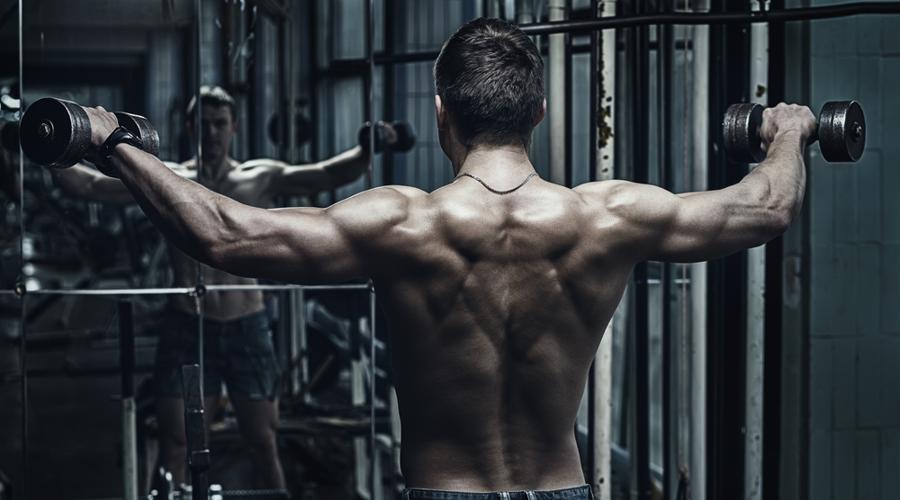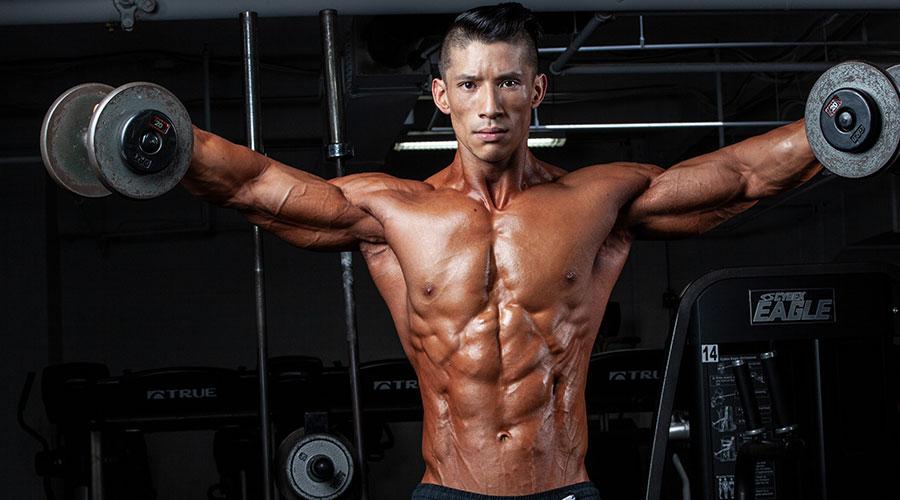Are you tired of feeling weak or experiencing discomfort in your shoulders? If so, it’s time to take action and prioritize your shoulder strength. Whether you’re an athlete aiming to enhance performance or simply someone looking to improve overall fitness, having strong and stable shoulders is essential. In this blog post, we will explore the best 3 exercises for shoulders to maximize your shoulder strength and help you achieve outstanding results.
Picture yourself effortlessly lifting weights, performing daily activities without pain or strain, or excelling in sports with a renewed sense of power. These exercises are carefully selected to target the key muscles in your shoulders, promoting stability, mobility, and resilience. From proven classics to innovative movements, we will guide you through each exercise, highlighting their benefits and providing step-by-step instructions for proper execution. By incorporating these exercises into your workout routine, you can transform your shoulder strength and reap the rewards both in and out of the gym.
Get ready to unlock the potential of your shoulders and embark on a journey towards enhanced strength and functionality. Say goodbye to limitations and hello to a stronger, more confident you. Let’s dive into the best 3 exercises for shoulders and discover the path to maximizing your shoulder strength.
Read here about buy trenbolone online
Contents
Importance of Shoulder Strength
Shoulder strength holds significant importance in various aspects of physical well-being. Firstly, strong shoulders play a crucial role in enhancing performance across different sports and physical activities. Whether you’re a competitive athlete or someone who enjoys recreational exercise, having robust shoulder muscles provides the necessary stability and power for optimal performance in upper body movements.
Additionally, shoulder strength is vital for injury prevention. Weak shoulders are more susceptible to injuries, especially in activities involving repetitive motions or heavy loads. By focusing on building shoulder strength, you can stabilize the shoulder joint, reducing the risk of common injuries such as rotator cuff tears, impingement syndrome, or dislocations. Strengthening the muscles around the shoulders provides valuable support and protection, enabling you to engage in physical activities more safely and confidently.

Exercise 1: Overhead Press
The overhead press is a fundamental exercise that targets the shoulder muscles and is a staple in many strength training routines. By pressing weight overhead, you engage the deltoids, trapezius, triceps, and other supporting muscles, promoting upper body strength and stability. In this section, we will delve into the muscle groups targeted, provide step-by-step instructions for proper execution, and offer valuable tips for variations or modifications to customize the exercise according to individual needs.
Muscle targeted
The overhead press primarily targets the deltoid muscles, which are responsible for the roundness and definition of the shoulders. Specifically, it focuses on the anterior deltoid (front of the shoulder), medial deltoid (middle of the shoulder), and the trapezius (upper back). The triceps brachii, located at the back of the upper arm, also come into play as synergistic muscles during the exercise. By performing the overhead press correctly, you can effectively strengthen and develop these muscle groups, enhancing shoulder stability and upper body strength.
Step-by-step instructions
To perform the overhead press:
- Begin by standing or sitting with your feet shoulder-width apart and the weight positioned at shoulder level.
- Grasp the weight with an overhand grip slightly wider than shoulder-width apart.
- Engage your core and maintain a neutral spine.
- Press the weight overhead in a smooth and controlled manner, fully extending your arms without locking out the elbows.
- Hold the weight overhead for a brief pause, then lower it back down to the starting position.
- Repeat the movement for the desired number of repetitions, maintaining proper form throughout.
Tips for variations or modifications
If you’re new to the overhead press or working with limited shoulder mobility, you can start with a lighter weight or utilize a resistance band for added support.
- Incorporating dumbbells, barbells, or kettlebells allows for different grip variations and challenges the muscles in unique ways.
- To target specific shoulder areas, you can adjust the grip width or hand placement (e.g., palms facing inward or outward).
- Performing the exercise in a seated position can provide additional stability and isolate the shoulder muscles.
- Gradually increase the weight as you progress, ensuring proper form and avoiding excessive strain on the shoulders.
By understanding the muscles targeted, following step-by-step instructions, and utilizing variations or modifications, you can optimize the benefits of the overhead press exercise, effectively strengthening your shoulders and enhancing overall upper body strength.
Discover the best exercises for strong shoulders! Click here!
Exercise 2: Bent-Over Rows
Bent-over rows are a highly effective exercise for targeting the muscles of the back, including the rhomboids, latissimus dorsi, trapezius, and biceps. This compound movement helps to improve posture, build upper body strength, and enhance overall back development. In this section, we will explore the muscles targeted by bent-over rows, provide step-by-step instructions for proper execution, and offer valuable tips for variations or modifications to tailor the exercise to individual needs.
More info about trenbolone acetate pills
Muscle targeted
Bent-over rows primarily target the muscles of the upper back. The rhomboids, located between the shoulder blades, are heavily engaged during the pulling motion. The latissimus dorsi, commonly referred to as the “lats,” are the broad muscles of the back that contribute to width and strength. Additionally, the trapezius muscles, located in the upper and middle back, along with the biceps, play a secondary role in assisting the movement. By performing bent-over rows, you can effectively strengthen and develop these muscle groups, promoting improved posture, back strength, and overall upper body aesthetics.
Step-by-step instructions
To perform bent-over rows:
- Stand with your feet shoulder-width apart, knees slightly bent, and hold a barbell or dumbbells with an overhand grip.
- Bend forward at the hips while keeping your back straight, maintaining a neutral spine.
- Engage your core and retract your shoulder blades, keeping them down and back throughout the movement.
- Pull the weight towards your lower chest by driving your elbows back, squeezing your shoulder blades together at the top.
- Pause briefly, then slowly lower the weight back to the starting position, maintaining control.
- Repeat the movement for the desired number of repetitions, focusing on maintaining proper form and engaging the targeted muscles.
Tips for variations or modifications
- If you’re new to bent-over rows or have lower back concerns, you can start with lighter weights or use resistance bands to provide added support.
- Experiment with different grip variations, such as an underhand or wide grip, to target specific muscles within the back.
- Utilize equipment like cables, kettlebells, or resistance bands to add variety and challenge the muscles in different ways.
- For individuals with limited mobility or flexibility, performing single-arm bent-over rows can be an effective alternative.
- Gradually increase the weight as you progress, ensuring proper form and avoiding excessive strain on the lower back.
By understanding the muscles targeted, following step-by-step instructions, and incorporating variations or modifications, you can effectively perform bent-over rows to strengthen your upper back, improve posture, and enhance overall upper body strength.

Exercise 3: Lateral Raises
Lateral raises are a key exercise for targeting the deltoid muscles, specifically the lateral head. This exercise helps to develop shoulder width, enhance shoulder stability, and improve overall upper body aesthetics. Lateral raises are commonly performed with dumbbells and are highly effective for isolating and strengthening the shoulder muscles. In this section, we will explore the muscles targeted by lateral raises, provide step-by-step instructions for proper execution, and offer valuable tips for variations or modifications to customize the exercise according to individual needs.
Muscle targeted
Lateral raises primarily target the lateral head of the deltoid muscles, which are located on the sides of the shoulders. These muscles are responsible for shoulder abduction, which is the movement of lifting the arms out to the sides away from the body. Lateral raises also engage the trapezius muscles, specifically the middle fibers, and the rotator cuff muscles to a lesser extent. By performing lateral raises correctly, you can effectively strengthen and develop these muscle groups, leading to improved shoulder stability and a well-rounded shoulder appearance.
Step-by-step instructions
To perform lateral raises:
- Stand with your feet shoulder-width apart, holding a dumbbell in each hand by your sides.
- Keep a slight bend in your elbows and maintain a neutral spine with your core engaged.
- Initiate the movement by lifting both arms out to the sides, keeping them parallel to the floor.
- Continue raising your arms until they reach shoulder level or slightly above, while maintaining control.
- Pause briefly at the top of the movement, then slowly lower the dumbbells back to the starting position.
- Repeat the movement for the desired number of repetitions, focusing on maintaining proper form and engaging the targeted muscles throughout.
Tips for variations or modifications
- Adjust the weight of the dumbbells based on your strength level and goals. Start with lighter weights and gradually increase as you progress.
- Experiment with different hand positions, such as thumbs up or thumbs facing forward, to target the muscles from slightly different angles.
- If you have limited range of motion or joint issues, perform seated lateral raises using a bench or an adjustable seat for added support.
- To increase intensity, you can perform lateral raises using resistance bands or cables.
- Focus on maintaining controlled movements throughout the exercise and avoid swinging or using momentum to lift the weights.
By understanding the muscles targeted, following step-by-step instructions, and incorporating variations or modifications, you can effectively perform lateral raises to strengthen your lateral deltoids, enhance shoulder stability, and achieve well-rounded shoulder development.
Click here to learn the top shoulder exercises!
Best 3 Exercises for Shoulders (Equipment-Based)
Strengthen and develop your shoulder muscles with these highly effective exercises using different equipment:
| Exercise | Dumbbell Shoulder Press | Standing Barbell Press | Cable Lateral Raise |
|---|---|---|---|
| Muscle Targeted | Deltoids | Deltoids | Deltoids |
| Equipment | Dumbbells | Barbell | Cable machine |
| Difficulty | Intermediate | Advanced | Intermediate |
| Execution | Sit on a bench, press dumbbells upward. Stand, press barbell overhead. Stand, raise arm with cable. |
||
| Benefits | Targets deltoids, full range of motion. Emphasizes anterior deltoids, allows heavier lifting. Targets lateral deltoids, constant tension. |
||
| Precautions | Avoid arching back, maintain form. Keep core tight, neutral spine. Avoid swinging, control cable handle. |
Best 3 Exercises for Shoulders (Bodyweight-Based)
If you prefer bodyweight exercises or don’t have access to equipment, there are effective options to target and strengthen your shoulder muscles. Here are three bodyweight-based exercises for your deltoids:
| Exercise | Handstand Push-Ups | Pike Push-Ups | Shoulder Taps |
|---|---|---|---|
| Muscle Targeted | Deltoids | Deltoids | Deltoids |
| Difficulty | Advanced | Intermediate | Beginner |
| Execution | Perform push-ups in a handstand position. | Perform push-ups with hips in the air. | Plank position, tap opposite shoulders. |
| Benefits | Targets deltoids, builds upper body strength. | Focused on deltoids, engages core muscles. | Targets deltoids, improves stability. |
| Precautions | Master regular push-ups first, use a spotter. | Maintain proper form, avoid sagging or arching. | Maintain a plank position, control movement. |
Combining the Exercises: Creating a Shoulder-Strengthening Routine
To maximize your shoulder strength and overall development, it’s essential to combine the three exercises we discussed—overhead press, bent-over rows, and lateral raises—into a well-rounded shoulder-strengthening routine. Here’s how you can create an effective routine:
- Warm-up: Start with a dynamic warm-up to increase blood flow and prepare your shoulders for the exercises. This can include arm circles, shoulder rolls, and shoulder mobility exercises.
- Exercise 1: Overhead Press – Perform 3-4 sets of 8-12 repetitions. Focus on maintaining proper form and engaging the shoulder muscles throughout each rep. Gradually increase the weight as you progress.
- Exercise 2: Bent-Over Rows – Perform 3-4 sets of 8-12 repetitions. Ensure a stable stance, maintain a neutral spine, and engage your back muscles while pulling the weight. Use challenging weights while maintaining proper form.
- Exercise 3: Lateral Raises – Perform 3-4 sets of 10-15 repetitions. Keep a controlled motion and focus on engaging the lateral deltoids. Adjust the weight according to your strength level and aim for a challenging but manageable load.
- Rest and Recovery: Allow for adequate rest between sets (around 60-90 seconds) and take a longer rest (1-2 minutes) between each exercise. Listen to your body and adjust the rest times as needed.
- Additional Shoulder Exercises: Depending on your preferences and time availability, you can incorporate additional shoulder exercises such as front raises, rear delt flyes, or shoulder presses to further target different areas of the shoulders. However, be mindful not to overdo it and maintain proper form.
- Stretching and Cool-Down: Once you’ve completed the exercises, finish with static stretches for the shoulders, such as shoulder stretches or chest stretches, to promote flexibility and aid in recovery.

Remember, it’s crucial to prioritize proper form, gradually increase weights or resistance, and listen to your body. If you’re new to these exercises or have any existing shoulder issues, consult with a qualified fitness professional to ensure safe and effective implementation of the routine. Stay consistent, challenge yourself progressively, and enjoy the benefits of a well-rounded shoulder-strengthening routine.
Get started with the best shoulder workouts now! Click here!
Maximizing Results of Best 3 Exercises for Shoulders
To maximize the results of the best three exercises for shoulders, consider the following tips and strategies:
- Consistency is Key: Make these exercises a regular part of your workout routine. Aim to perform them at least two to three times per week to allow for sufficient stimulus and adaptation.
- Proper Form and Technique: Focus on maintaining proper form throughout each exercise. This ensures that you’re targeting the intended muscles effectively and reduces the risk of injury. If needed, seek guidance from a fitness professional to ensure correct execution.
- Progressive Overload: To continue making progress, gradually increase the intensity of your workouts. This can be done by adding more weight, increasing repetitions, or incorporating more challenging variations of the exercises. Progressive overload stimulates muscle growth and strength gains.
- Mind-Muscle Connection: Develop a strong mind-muscle connection by consciously focusing on the targeted muscles during each exercise. Visualize the muscles working and actively engage them throughout the movement. This enhances muscle activation and improves the effectiveness of the exercises.
- Balanced Training: While the best three exercises for shoulders are essential, it’s important to maintain a well-rounded training program. Incorporate exercises that target other muscle groups as well to ensure overall muscular balance and prevent muscle imbalances or postural issues.
- Rest and Recovery: Allow sufficient rest and recovery time between workouts to allow your muscles to repair and grow stronger. Overtraining can hinder progress and increase the risk of injury. Listen to your body and give yourself adequate rest days.
- Nutrition and Hydration: Support your workouts with a balanced and nutritious diet. Ensure you’re consuming enough protein to support muscle growth and repair. Stay hydrated to optimize performance and recovery.
- Adjust for Individual Needs: Modify the exercises based on your individual fitness level, mobility, and any specific needs or limitations. Seek professional guidance if necessary to tailor the exercises to your unique circumstances.
By following these tips and strategies, you can maximize the results of the best three exercises for shoulders, achieving optimal shoulder strength, stability, and overall upper body development. Remember to prioritize safety, listen to your body, and enjoy the journey towards stronger, healthier shoulders.
FAQ – Best 3 Exercises for Shoulders
Q: What are the benefits of dumbbell shoulder press?
A: The dumbbell shoulder press targets the deltoids and provides a full range of motion. It helps to strengthen and develop the shoulder muscles, engages stabilizing muscles, and promotes overall upper body strength.
Q: How to perform a standing barbell press correctly?
A: To perform a standing barbell press, stand with your feet shoulder-width apart, hold a barbell at shoulder level, and press the barbell overhead until your arms are fully extended. Lower the barbell back to the starting position with control. It primarily targets the deltoids, emphasizes the anterior deltoids, and engages core muscles for stability.
Q: What are the precautions for cable lateral raise?
A: When performing cable lateral raises, it’s important to avoid swinging or jerking motions. Keep your shoulder relaxed throughout the exercise and maintain control of the cable handle. This exercise targets the lateral deltoids, offers constant tension on the muscle, and provides a smooth and controlled movement.
